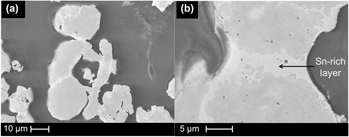Crossref Citations
This article has been cited by the following publications. This list is generated based on data provided by
Crossref.
Zhou, Xin
Li, Kailun
Zhang, Dandan
Liu, Xihe
Ma, Jing
Liu, Wei
and
Shen, Zhijian
2015.
Textures formed in a CoCrMo alloy by selective laser melting.
Journal of Alloys and Compounds,
Vol. 631,
Issue. ,
p.
153.
Shirazi, Seyed Farid Seyed
Gharehkhani, Samira
Mehrali, Mehdi
Yarmand, Hooman
Metselaar, Hendrik Simon Cornelis
Adib Kadri, Nahrizul
and
Osman, Noor Azuan Abu
2015.
A review on powder-based additive manufacturing for tissue engineering: selective laser sintering and inkjet 3D printing.
Science and Technology of Advanced Materials,
Vol. 16,
Issue. 3,
p.
033502.
Nassef, Ahmed
and
El-Hadek, Medhat
2016.
Microstructure and Mechanical Behavior of Hot Pressed Cu-Sn Powder Alloys.
Advances in Materials Science and Engineering,
Vol. 2016,
Issue. ,
p.
1.
Oderinde, Olayinka
Liu, Shunli
Li, Kewen
Kang, Mengmeng
Imtiaz, Hussain
Yao, Fang
and
Fu, Guodong
2018.
Multifaceted polymeric materials in three‐dimensional processing (3DP) technologies: Current progress and prospects.
Polymers for Advanced Technologies,
Vol. 29,
Issue. 6,
p.
1586.
Guan, Jieren
Zhang, Xiaowei
Jiang, Yehua
and
Yan, Yongnian
2019.
Insights into fabrication mechanism of pure copper thin wall components by selective infrared laser melting.
Rapid Prototyping Journal,
Vol. 25,
Issue. 8,
p.
1388.
Chen, Xibao
Chen, Gang
Wang, Gang
Zhu, Peizhi
and
Gao, Chunxia
2020.
Recent Progress on 3D‐Printed Polylactic Acid and Its Applications in Bone Repair.
Advanced Engineering Materials,
Vol. 22,
Issue. 4,
Hassani, Mohsen
Jeong, Robin
Sandwell, Allen
and
Park, Simon S.
2020.
Enhanced Hybrid Copper Conductive Ink for Low Power Selective Laser Sintering.
Procedia Manufacturing,
Vol. 48,
Issue. ,
p.
743.
Wang, Hao
Guo, Liang
Nie, Zhen
Lyu, Qitao
and
Zhang, Qingmao
2021.
Processing Technologies and Properties of Cu-10Sn Formed by Selective Laser Melting Combined with Heat Treatment.
3D Printing and Additive Manufacturing,
Vol. 8,
Issue. 1,
p.
13.
Chen, Siyu
Wang, Jun
Yuan, Zhao
Wang, Zhe
and
Du, Dan
2021.
Microstructure and arc erosion behaviors of Ag-CuO contact material prepared by selective laser melting.
Journal of Alloys and Compounds,
Vol. 860,
Issue. ,
p.
158494.
Svetlizky, David
Kazimierczak, Honorata
Ovadia, Bar
Sharoni, Ariel
and
Eliaz, Noam
2021.
Electrochemical Processing and Thermal Properties of Functional Core/Multi-Shell ZnAl/Ni/NiP Microparticles.
Materials,
Vol. 14,
Issue. 4,
p.
834.
Liu, Yantao
Ye, Zhanggen
Wang, Xue
Liang, Bo
and
Zhang, Yongzhong
2021.
Microstructure and mechanical behavior of Cu–9Al–4Ni-3.5Fe-0.5Mn alloy fabricated by laser melting deposition.
Materials Science and Engineering: A,
Vol. 826,
Issue. ,
p.
142006.
Srivastava, Manu
Rathee, Sandeep
Patel, Vivek
Kumar, Atul
and
Koppad, Praveennath G.
2022.
A review of various materials for additive manufacturing: Recent trends and processing issues.
Journal of Materials Research and Technology,
Vol. 21,
Issue. ,
p.
2612.
Yang, Peng
Guo, Xingye
He, Dingyong
Shao, Wei
Tan, Zhen
Fu, Hanguang
Zhou, Zhenlu
and
Zhang, Xiaoya
2022.
Microstructure Twinning and Mechanical Properties of Laser Melted Cu-10Sn Alloy for High Strength and Plasticity.
Journal of Materials Engineering and Performance,
Vol. 31,
Issue. 4,
p.
2624.
Mustapha, Khairul Azhar
Shikh Anuar, Fadhilah
and
Mohd Saat, Fatimah Al-Zahrah
2022.
Prediction of Slip Velocity at the Interface of Open-Cell Metal Foam Using 3D Printed Foams.
Colloids and Interfaces,
Vol. 6,
Issue. 4,
p.
80.
Sharabian, Elmira
Leary, Martin
Fraser, Darren
and
Gulizia, Stefan
2022.
Electron beam powder bed fusion of copper components: a review of mechanical properties and research opportunities.
The International Journal of Advanced Manufacturing Technology,
Vol. 122,
Issue. 2,
p.
513.
Shanthar, Rajinth
Chen, Kun
and
Abeykoon, Chamil
2023.
Powder‐Based Additive Manufacturing: A Critical Review of Materials, Methods, Opportunities, and Challenges.
Advanced Engineering Materials,
Vol. 25,
Issue. 19,
Vahedi Nemani, Alireza
Ghaffari, Mahya
Sabet Bokati, Kazem
Valizade, Nima
Afshari, Elham
and
Nasiri, Ali
2024.
Advancements in Additive Manufacturing for Copper-Based Alloys and Composites: A Comprehensive Review.
Journal of Manufacturing and Materials Processing,
Vol. 8,
Issue. 2,
p.
54.
